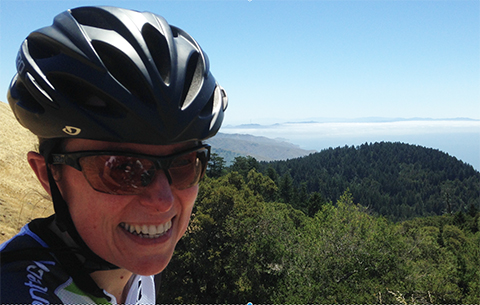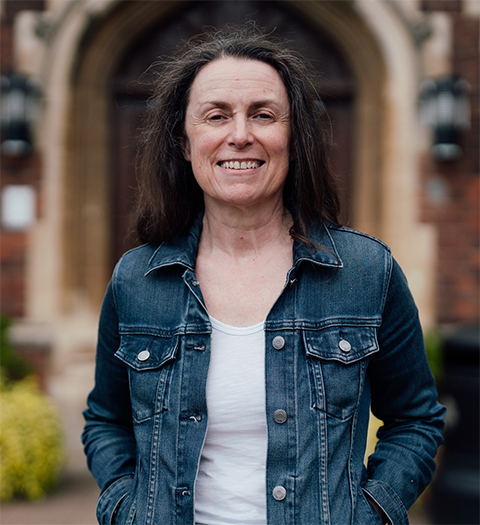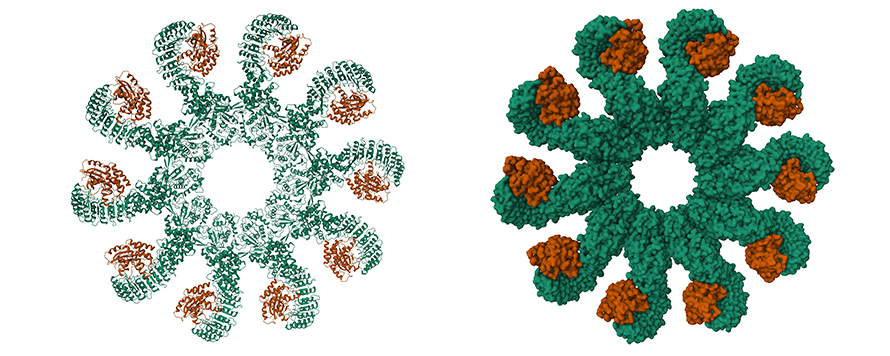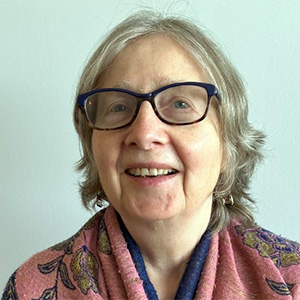Meet Clare Bryant
Clare Bryant remembers the moment she fell in love with research. As an undergraduate, she secured a summer job with a British Ministry of Defense team conducting biological research she is still not free to discuss. Yet, it was the science — not the secrecy — that electrified Bryant.
“Honestly, it was like somebody switched on a light,” she recalled. “It was just so exciting to be trying to work something out, something unknown.”

Bryant went on to finish her bachelor’s degree in biochemistry and physiology at the University of Southampton. Her father, a doctor, had encouraged her interest in medicine, but she opted to pursue veterinary studies at the University of London, where she also earned a doctorate.
She completed her postdoctoral studies with John Vane, a pharmacologist and Nobel laureate, pursuing a Wellcome fellowship based jointly at his William Harvey Research Institute at St. Bartholomew’s Hospital Medical College and at the Royal Veterinary College, both in London.
Since 2013, Bryant has been a professor of innate immunity at the University of Cambridge in the United Kingdom, where she works with the departments of medicine and veterinary medicine. Her research collaborations are interdisciplinary and global, uniting scientists from Europe, Singapore, Australia and the United States in fields such as biology (immunology, structural biology, genetics, molecular biology and pharmacology), physics, mathematics and chemistry.
Bryant spoke with ASBMB Today about her research career and role as an associate editor at the Journal of Biological Chemistry. The interview has been edited for clarity and length.
What sparked your interest in veterinary science and immunology?
Bryant: I live a kind of quasi-life as a scientist and vet. People in science don’t know I’m a vet, and vets don’t know I’m a scientist. I don’t really mind that: I feel blessed to be recognized in two fields as a very capable individual.
I decided to pursue a veterinary degree because it was what I had always wanted to do. Once I got into clinical work, though, I realized I couldn’t answer questions in sufficient detail to give me job satisfaction. So I pursued research.
I think my career would have been more straightforward if I had been a physician. To get funding to do medical research as a physician is without a doubt easier than it is to get it as a vet. Yet, I think my career would have not been as diverse and interesting. By a really interesting series of happy accidents, I feel I’ve been lucky. I’m driven and very hardworking, but I do feel like I’ve had some good breaks along the way.
What I realized over my career is that I want answers. That’s been what the whole of my careerhass focused on: asking what I consider to be interesting scientific questions and trying to find answers. I’ve meandered around, and my research was initially in pharmacology. But then I started to work on innate immune receptors. Pharmacology doesn’t really do that, so I became rebranded as an innate immunologist. I consider myself a receptor biologist.
I’m really interested in fundamental mechanisms, in innate immunity — and in translating that into the clinic. I do a lot of work with industry for humans and human medicines, predominantly, but some animal medicines, too. I still do a little bit of clinical work.
Tell me about your postdoc with Nobel laureate John Vane.

Bryant: He was amazing, the brightest person I’ve ever met. It was a fantastic education working in his institute. I learned so much about really smart people and about standards of professional behavior and scientific integrity.
I am obsessed with making sure my science is true. That means controls, careful experimental design and checking and cross-checking things. I’m very thorough, and sometimes that means I’m a bit slow to publish because I’m most concerned with making sure that our papers are scientifically solid. I am reluctant to rush things out to tell a good story unless I am sure the data is robust. This was a lesson I learned from John Vane, who would always spot any tiny holes in my work and would send me back to the lab to do more experiments!
There was breathtakingly exciting science in his lab. We were studying cyclo-oxygenase. A novel form of it was discovered that was really important for inflammation. This then triggered a whole new program of pharmaceutical work on discovering new anti-inflammatory drugs. But, unfortunately, one of the new drugs wasn’t just anti-inflammatory: It also predisposed older people to having heart attacks.
The moral of the story, at least for me, is that biology is rarely simple. It shows the importance of fundamental science to drug discovery but also to drug safety. In other words, when you discover a drug, that’s not where it stops. This illustrates why you have to continue to work on the biology.
What is it like doing research at Cambridge?
Bryant: I do a lot of collaborative work in Cambridge and internationally. In fact, I don’t understand how anybody can do science without collaboration. For me, a lot of my research is with people in the physical sciences.
The reason for that is, when I have a question to ask, there are various techniques we can use to answer the question. By working with people in the physical sciences, I am not limited to standard experimental approaches. We can create the solutions; we can create new techniques to answer questions, and that is really exciting.
Plus, I have the benefit of working with fantastic people in immunology, infectious diseases and clinical medicine. In my opinion, that’s what makes Cambridge a great place to work.
What are you working on right now?
Bryant: One of my projects is focused on understanding inflammasomes and cell death complexes — how they’re structured and how they function. There’s a second facet to the project, which I find super interesting as well — how they’ve changed through evolution in animals and the impacts of that on zoonotic infections. It’s the pathogens that don’t cause much disease in animals but do cause problems in people that I’m interested in. I’ve been doing this kind of research for years, but it’s just gotten fashionable since the COVID-19 pandemic.
There are such big differences in the innate immune system between birds, different species of mammals and humans. This presents new ways of understanding and preventing zoonotic infections but also treating them.
What is it like now being part of the JBC editorial team? What do you look for in a paper?
Bryant: When I was doing a postdoc in John Vane’s lab, JBC was considered the best biochemical journal to publish in. I was super excited to get my first paper into JBC. It has stayed with me as the top biochemical journal, the pinnacle of biochemistry, so I was very excited to be asked to be an associate editor.
A paper I’m reviewing must have an adequate number of repeats. Doing an experiment once is not enough. That’s one thing that concerns me, because, in the rush to publish, the temptation is not to do enough experimental repeats, just to generate a good story, so your paper gets out as quickly as possible. I am even more concerned about problems like image manipulation, manufactured data and other types of fraud as I am not sure I will easily spot them and I am unsure of whether ChatGPT is going to be an issue or a benefit!

How do you explain your research to the public?
Bryant: When I try to explain scientific research to somebody, I say that it’s an evolving mystery. Each time we get an answer to something, and each time I get to understand a mechanism, that’s really exciting.
Also, there’s the potential to discover something that’s going to change people’s lives because you can make a drug or another therapeutic. So, it’s about solving a mystery and generating a solution all in one.
Do you have any hobbies?
Bryant: I love the theater, but I don’t go very often. I’m an enthusiastic gardener, though. I grow all sorts of things, but I have a very traditional English garden with lots of flowers. I run and cycle. I’m also an embryonic mosaic artist; I find Roman and Greek art very beautiful.
Enjoy reading ASBMB Today?
Become a member to receive the print edition four times a year and the digital edition monthly.
Learn moreGet the latest from ASBMB Today
Enter your email address, and we’ll send you a weekly email with recent articles, interviews and more.
Latest in People
People highlights or most popular articles

In memoriam: Michael J. Chamberlin
He discovered RNA polymerase and was an ASBMB member for nearly 60 years.

Building the blueprint to block HIV
Wesley Sundquist will present his work on the HIV capsid and revolutionary drug, Lenacapavir, at the ASBMB Annual Meeting, March 7–10, in Maryland.

In memoriam: Alan G. Goodridge
He made pioneering discoveries on lipid metabolism and was an ASBMB member since 1971.

Alrubaye wins research and teaching awards
He was honored at the NACTA 2025 conference for the Educator Award and at the U of A State and National Awards reception for the Faculty Gold Medal.

Designing life’s building blocks with AI
Tanja Kortemme, a professor at the University of California, San Francisco, will discuss her research using computational biology to engineer proteins at the 2026 ASBMB Annual Meeting.

Jordahl named Gilliam Fellow
He will receive three years of funding to support his thesis research.

